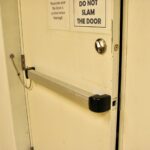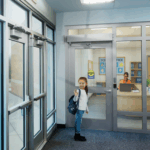Here’s my next article – let me know if I missed anything before it goes to print! This article will be published in the February 2020 issue of Door Security + Safety
.

Most of the code questions that arise on a project are very specific: Does Door 101 require panic hardware? Is the electromagnetic lock in Hardware Set 4 required to be listed to UL 294? Is gasketing mandated for the patient room doors in the memory care wing? Before these questions can be answered, however, it’s important to understand the fundamentals of codes – a solid foundation upon which to build. This article will address 3 topics that are crucial for anyone who works with the model building codes and fire codes, state modifications, referenced standards and accessibility requirements.
Which set of code requirements must be followed? Which code supersedes the others?
 The first step when researching a code issue is to identify which code publication – and which edition of that document – has been adopted in the project’s jurisdiction. When should the International Building Code (IBC) be referenced, or the International Fire Code (IFC), NFPA 101 – Life Safety Code, or a different code altogether? Different editions of the codes often have varying requirements, and what about all of those state code modifications and referenced standards?
The first step when researching a code issue is to identify which code publication – and which edition of that document – has been adopted in the project’s jurisdiction. When should the International Building Code (IBC) be referenced, or the International Fire Code (IFC), NFPA 101 – Life Safety Code, or a different code altogether? Different editions of the codes often have varying requirements, and what about all of those state code modifications and referenced standards?
If the building is in the design or construction phase, or undergoing a renovation, the applicable code would typically be the building code that was in effect when the building permit was issued. If it’s an existing building, the adopted fire code would be used, or possibly the existing building code, depending on the project and the jurisdiction. Most states adopt a building code and a fire code, often with state modifications. If a state does not adopt a building code or fire code, the larger cities within that state may adopt these codes. In some cases, cities will make their own code modifications, even if the state has adopted a code for use statewide.
Many states also adopt accessibility standards, which could be part of the state building code, or might be a separate publication. The Americans with Disabilities Act is a federal law, so the ADA Standards for Accessible Design could be enforced across the country. To complicate matters further, some buildings must comply with codes that are different from the codes that have been adopted by the state. Often those projects will have to comply with the most stringent requirements of each applicable code.
Let’s use Massachusetts as an example:
By using Google to search for “Massachusetts State Building Code”, I found that Massachusetts adopted the 9th edition of the Massachusetts State Building Code on October 20, 2017, with a concurrency period that extended until the last day of 2017. Building permits issued during the concurrency period could either be permitted under the 8th or 9th edition of the code. The 9th edition is based on the 2015 edition of the International Building Code, with Massachusetts amendments. To get a complete understanding of a particular code requirement, both the 2015 IBC and the 9th edition amendments would have to be consulted.
For new and existing buildings in Massachusetts, the fire marshal will enforce the adopted fire code. A search for “Massachusetts State Fire Code” leads to a state government page which says that as of January 1, 2018, Massachusetts adopted the 2015 edition of NFPA 1 – Fire Code, with some Massachusetts amendments. NFPA 1 references NFPA 101 – Life Safety Code for means of egress requirements. Massachusetts fire code officials are enforcing a different code than the building code officials, which could create conflicts between the two sets of requirements.
Searching for “Massachusetts Accessibility Standards” leads to information about the Massachusetts Architectural Access Board, as well as links to the current and past editions of the Massachusetts AAB standards (521 CMR). These state standards are similar to the national accessibility standards – the ADA Standards for Accessible Design, and ICC A117.1 – Accessible and Usable Buildings and Facilities. However, there are some differences between these publications. For example, the national standards require operable hardware to be mounted between 34 inches and 48 inches above the floor, but the Massachusetts standards require operable hardware to be mounted between 36 inches and 48 inches above the floor.
As previously mentioned, sometimes a code may be enforced that is different from those adopted by a state or jurisdiction. When Massachusetts health care facilities are surveyed by the Joint Commission (or another accrediting organization) on behalf of the Center for Medicare and Medicaid Services (CMS), the 2012 edition of NFPA 101 is currently enforced, even though the state building code and state fire code are based on other codes/editions.
There are additional codes and standards used in Massachusetts that could affect doors and hardware, including the electrical code, the energy code, the fire alarm code, and all of the standards referenced by the codes listed above. So, the question is…which code is THE code? Which requirements apply? The 9th-edition modifications include changes to the 2015 IBC, and the state accessibility standards add another layer of mandates. There are requirements of the 2015 edition of NFPA 101 that are different from the IBC. For example, NFPA 101 allows mechanical locks on the stair side of some stair doors – the IBC does not. Because the IBC is more stringent on this issue, the AHJ would require compliance with the IBC. Typically, the most stringent requirements must be followed, which requires familiarity with ALL of the codes.
Who is the Authority Having Jurisdiction (AHJ)? Who has the final say?
 When researching the codes and standards, it’s not uncommon to see references to the Authority Having Jurisdiction, or the AHJ. For instance, the term “approved” is defined by the National Fire Protection Association (NFPA) as: “acceptable to the authority having jurisdiction.” This means that whenever NFPA 101 – Life Safety Code refers to an “approved automatic sprinkler system” it is referencing a system that have been approved by the AHJ.
When researching the codes and standards, it’s not uncommon to see references to the Authority Having Jurisdiction, or the AHJ. For instance, the term “approved” is defined by the National Fire Protection Association (NFPA) as: “acceptable to the authority having jurisdiction.” This means that whenever NFPA 101 – Life Safety Code refers to an “approved automatic sprinkler system” it is referencing a system that have been approved by the AHJ.
In the NFPA codes and standards, the AHJ is defined as: “An organization, office, or individual responsible for enforcing the requirements of a code or standard, or for approving equipment, materials, an installation, or a procedure.” Annex A of NFPA 101 and NFPA 80 both contain a paragraph further explaining the definition of the AHJ. The explanatory information in the annex clarifies that jurisdictions and approval agencies vary, so the term is used broadly in NFPA documents. The AHJ may be a federal, state, local, or regional department or individual. It could be a fire chief, fire marshal, labor or health department, building inspector, electrical inspector, insurance inspector, or others having statutory authority. In some instances, the property owner may assume the role of the AHJ, and in government buildings, the AHJ is often the commanding officer or departmental official.
The IBC and the IFC use the term AHJ less frequently, but that is because those codes are more specific regarding which authority is enforcing the applicable code. In the IBC, the term “approved” is defined as: “acceptable to the building official” because the building official or building inspector would normally be enforcing the IBC. The IFC defines the term “approved” as: “acceptable to the fire code official” and includes many references to the fire code official throughout the code.
In short, the AHJ is the organization or individual that is responsible for enforcing a code. It is common to have more than one AHJ on a project, and often they are enforcing different codes. For example, during the construction phase of a new hospital, the building inspector would typically be the AHJ and would enforce the adopted building code. The local fire marshal would also be an AHJ and would enforce the adopted fire code – during construction and throughout the life of the building. If the facility receives funding from the Center for Medicare and Medicaid Services (CMS), the Joint Commission is often an AHJ, certifying that the facility is compliant with the standards adopted by CMS.
When using NFPA 101 – Life Safety Code, should the chapters for new or existing buildings be referenced? When does a new building become an existing building?
For most occupancy types, the Life Safety Code includes separate chapters containing requirements for new buildings and existing buildings. For example, Chapter 18 is called New Health Care Occupancies, and Chapter 19 is Existing Health Care Occupancies. Some of the requirements of the two chapters are the same and some are not. It’s pretty obvious when a building is new, but when does it become existing?
NFPA 101 defines an existing building as, “A building erected or officially authorized prior to the effective date of the adoption of this edition of the Code by the agency or jurisdiction.” Case in point, the adoption of NFPA 101-2012 by the Centers for Medicare and Medicaid Services (CMS) was effective on July 5, 2016. The memo announcing the adoption stated: “Buildings constructed before July 5, 2016 can meet Existing Occupancy requirements. In addition, buildings that receive design approval or building permits for construction before July 5, 2016 can meet Existing Occupancy requirements. All other building construction must meet New Occupancy requirements.” In addition, to qualify as existing, a building must have been in the CMS program prior to the date in the memo, and the building must have been built to health care standards.
When the requirements for existing buildings are less stringent than the requirements for new buildings, does this mean that a hospital built before 2016 only needs to meet the requirements for existing buildings? Not necessarily. If a building was designed and constructed to meet the life safety requirements for new buildings, NFPA 101 prohibits those features from being removed or reduced, stating: “No existing life safety feature shall be removed or reduced where such feature is a requirement for new construction.” (Refer to the NFPA 101 Handbook for examples.)
If the requirements for an existing building are more restrictive than the requirements for a new building, NFPA 101 does allow existing life safety features to be decreased to those required for new buildings. BUT – extreme caution is recommended, because the less-restrictive provisions might be the result of new requirements in other sections of the code. An example of this would be if an existing building was required to have corridors with a 1-hour fire-resistance rating, and a new building did not require the rated corridors, but this change was due to increased requirements for sprinkler systems. The corridor rating could not be reduced unless the sprinkler requirements were met.
The bottom line is…new buildings are those built (or those with building permits issued) after the adoption of the code, and existing buildings are those built (or permitted) before the adoption date. But a life-safety feature required when the building was new may not be removed or downgraded just because the building becomes an existing building at some point in time.
Conclusion
Codes can seem complicated, but taking the first step will help to simplify the process of interpreting the codes. Find out which codes apply to the project and understand how each of the publications addresses the issue in question. Follow the most restrictive of these requirements. For instance, if the adopted fire code requires panic hardware for doors serving certain occupancies with an occupant load of 100 people or more, and the adopted building code requires panic hardware for those occupancies when there is an occupant load of 50 people, the building code requirements are more restrictive and must be followed. The standards referenced by a code normally include more detailed requirements related to a specific building component or application. Modifications made by a state, county, or city will often incorporate changes to address issues particular to that area.
When questions arise, some codes and standards have a commentary or handbook version available with additional information, and many topics have been addressed on iDigHardware.com and in past Decoded articles. For official interpretations, consult the AHJ(s).
You need to login or register to bookmark/favorite this content.






Lori,
Is there a guide that you know of that has the codes and editions that each state uses?
You covered the healthcare issues fairly well. CMS (Center for Medicare/Medicaid Services) used to be way behind, We were still trying to meet 1987 codes well into the 1990’s. I think that has been fixed but I have been retired too long to know for sure. The other really big issue for healthcare facilities is the accreditation authorities such as the Joint Commission in my time. The inspections I went through were among the most detailed of any State or Local inspection and these folks knew how to apply the UL standards which had to be met to have a valid fire door that would have a valid result in a fire. We also occasionally met OSHA officials. These inspecting and authorizing authorities had a variety of understandings, some which did not make safety sense at times.
I think you like my examples from the past. A fire marshal toured the facility. At this time, Hospitals mostly used metal trash cans with plastic bags to allow reasonably safe movement of trash out of the cans and into the transport carts. This fire marshal looked at the trash can in a patient room and started to write up an order that all the liners had to be removed and no plastic bag would be allowed. As it happened, there was about 5 pounds of newspaper in the can. I pointed out to him that a few ounces of very thin plastic probably could not produce a serious problem when compared with the eminently flammable contents of a trash can so was that really a good recommendation?. “No, I suppose not.”
Yes – I LOVE your examples! Keep ’em coming! 🙂
– Lori
At one time, we nearly had a requirement that all patient room doors be automatic closing (held by electromagnet released by the fire alarm system) or self closing (closer always returned them to the closed and latched position). This was debated for a length of time and then dropped (except for psych type facilities as I recall – then some folks in these facilities used the arm to try and commit suicide), The objections for the fire situation was that in a patient wing there may be 20 or more corridor doors. If they were all suddenly closed by some smoke detector, the staff would need to reopen each door with the possibility that the door was serving to limit smoke or a fire. If a patient bed was involved, say with oxygen being administered, the delay to locate the fire could be fatal. The various arguments for and against were difficult to evaluate. The resolution was that the healthcare staff had a requirement to close the doors upon actuation of the fire alarm. They were very good at doing this.
I got a call at home one evening that the occupants of a 2 story patient wing smelled something burning but there was no sign of fire or smoke. I asked the caller if the fire alarm had been actuated, if not do so, I would be there in 10 minutes. When I got there, I found no fire alarm but a call had been placed to the fire division. There were staff and firemen throughout the wing and all doors were open. There was an obvious odor of burning paper or cloth. I told the responding chief I was going to pull the fire alarm and silence it to stop the ventilation fans. My theory was that unless that was done, the smoke would not be concentrated enough to locate its source. He agreed. In about 5 minutes, it was obvious that the smoke was coming from a patient room. We all converged. We asked the patient if there was any reason smoke was coming form his room and he denied all knowledge. About that time, we notice several burning coals falling at the edge of the bed pan onto the floor. The patient was laying on a burning mattress. This was quickly dealt with and moved outside where it continued to smolder even after water from the fire truck completely doused it. Upon questioning, the man admitted to smoking, falling asleep with a cigarette in his hand, waking when it burned him, using a cup full of water to “put it out”, then taking the sheets off, turning the mattress over, remaking the bed and climbing back into it. He was being hospitalized for pulmonary (lung) problems and begged us not to tell Dr. L. about the smoking. Just another day at the Hospital for the Plant Operations folks. So much of what is part of the construction of the healthcare buildings forms a vital part of the safety. Even thought consulting fire authorities could result in some pain, I always treasured the input and never hesitated getting permission from the authorities of jurisdiction. I was well read but they always brought a perspective gained by their experiences. This is probably a bit off topic.
Wow – what a story! I’m sure you saw all kinds of crazy stuff!
Did I ever tell you about the time when I spent several days on a ladder replacing 109 automatic-closing units in a nursing home (not LCN units)? On the very last one, the cover wouldn’t go on, so I gave it a little whack and it pinched a wire, shorted out, and all of the @#$%& doors closed. Oops.
– Lori